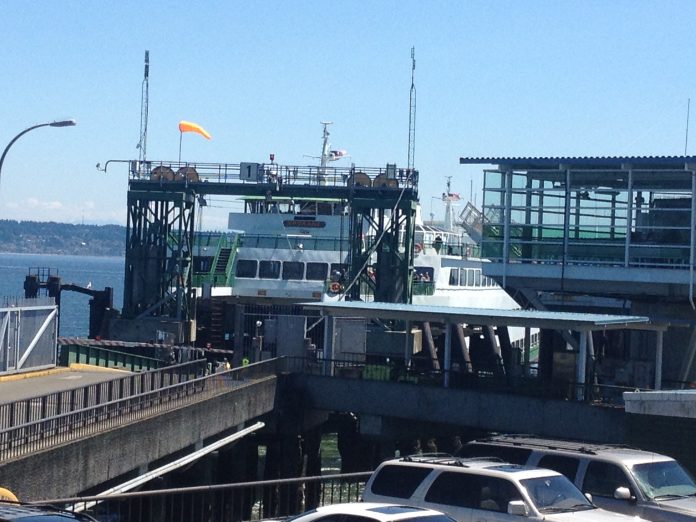It was a given that the pandemic would depress ferry ridership, but Washington State Ferries (WSF) has reported an astonishing 41% ridership decline in 2020–the lowest ridership since 1975. Almost 10 million fewer riders took the state ferries in 2020 than they did in 2019, meaning that only 13,986,702 riders sailed across Puget Sound and Rosario Strait during the year. Annual ridership was also down in 2019, but only by a modest 3.4%. That was largely due to the snowpocalypse that year, but the system had experienced substantial growth during the 2010s reaching a 16-year high in 2018.
WSF attributes last year’s ridership declines to state and local government stay-at-home and telecommuting public health orders as well as much lower regional tourism and social activities, all of which are due to the pandemic. Some of the ridership decline can also be attributed to fewer scheduled trips by WSF (including full cancellation of Sidney, British Columbia service), discouraging would-be riders from taking trips.
“When COVID-19 drastically altered ridership patterns, we quickly adjusted service to match this new reality,” said WSF Assistant Secretary Amy Scarton in a statement. “Since late summer, we’ve been incrementally restoring sailings based on our COVID Response Service Plan, which considers demand, crew availability, vessel availability and funding.”
Walk-on passenger ridership is the most acute area of decline. Ridership reports show a systemwide decline of 68.1% to 2.22 million, down from 6.96 million in 2019. Among this category, Seattle routes to Bainbridge Island and Bremerton topped the list with declines over 70%. Bainbridge Island saw walk-on ridership tumble from 3.26 million in 2019 to 837,618 in 2020, a 74.3% decline. Bremerton saw walk-on ridership similarly collapse from 1.51 million in 2019 to 421,764 in 2020, a 72.0% decline. For other major routes, walk-on ridership declines were heavy but not quite as dramatic:
- Edmonds-Kingston saw ridership fall 50.8% from 676,816 to 332,764;
- Mukilteo-Clinton saw ridership fall 54.5% from 382,870 to 174,296
- Fauntleroy-Vashon saw ridership fall 66.8% from 298,210 to 98,954;
- Fauntleroy-Southworth saw ridership fall 60.8% from 142,827 to 55,921;
- Southworth-Vashon saw ridership fall 55.4% from 94,750 to 42,230; and
- Port Townsend-Coupville saw ridership fall 52.2% to 62,814.
Setting aside the San Juan Islands and Vancouver Island routes, the routes with the biggest absolute ridership declines shake out as follows:
- Seattle-Bainbridge with a 3.63 million decline to 2.58 million in 2020 (down 58.5%) from 6.21 million in 2019;
- Seattle-Bremerton with a 1.59 million decline to 874,715 in 2020 (down 64.4%) from 2.46 million in 2019;
- Edmonds-Kington with a 1.19 million decline to 2.93 million in 2020 (down 28.8%) from 4.12 million in 2019;
- Mukilteo-Clinton with a 1.06 million decline to 3.07 million in 2020 (down 25.7%) from 4.13 million in 2019;
- Fauntleroy-Vashon with a 675,338 decline to 1.20 million in 2020 (down 36.0%) from 1.88 million in 2019;
- Fauntleroy-Southworth with a 444,261 decline to 532,329 in 2020 (down 45.5%) from 976,590 in 2019;
- Port Townsend-Coupville with a 307,766 decline to 535,502 in 2020 (down 36.5%) from 843,268 in 2019;
- Tahlequah-Point Defiance with a 189,062 decline to 532,329 in 2020 (down 21.5%) from 879,044 in 2019; and
- Southworth-Vashon with a 68,026 decline to 150,040 in 2020 (down 31.2%) from 218,066 in 2019.
Interestingly, the 2020 ridership declines mean that the Mukilteo-Clinton route became the busiest route in the system accounting for 22.0% of all system ridership. The Edmonds-Kingston route was not too far behind with 21.0% of systemwide ridership. Usually the Seattle-Bainbridge Island route tops the list by a substantial margin. In 2019, the Seattle-Bainbridge Island route accounted 26.0% of system ridership but fell to 18.4% of system ridership in 2020 placing it in third.
However, ridership declines are notable throughout the San Juan Islands with a 32.6% decline on the Anacortes-Friday Harbror route, 31.7% decline on the Anacortes-Ocras route, 24.3% decline on the Anacortes-Lopez route, 18.5% decline on the Anacortes-Shaw route, and 19.9% decline inter-island.
With the pandemic in full force, it appears that the heaviest declines in absolute ridership and walk-on ridership have hit routes closest to Seattle, except where Seattle is the main or best option to reach the mainland. These trends from 2020 are really a testament to how many trips on WSF are white-collar commuter- and tourism-oriented.
Still, ridership declines have been slowing throughout the year. In the second quarter of 2020, WSF had reported a 60.1% systemwide ridership decline from the same period in 2019. By the third quarter, this had fallen a bit to a 43.5% decline. Then in the fourth quarter, the ridership decline was a bit lower at 40.3%. So things could be turning in the months ahead as the Biden and Inslee administrations move forward with vaccination campaigns and the pandemic resides.
Stephen is a professional urban planner in Puget Sound with a passion for sustainable, livable, and diverse cities. He is especially interested in how policies, regulations, and programs can promote positive outcomes for communities. With stints in great cities like Bellingham and Cork, Stephen currently lives in Seattle. He primarily covers land use and transportation issues and has been with The Urbanist since 2014.



